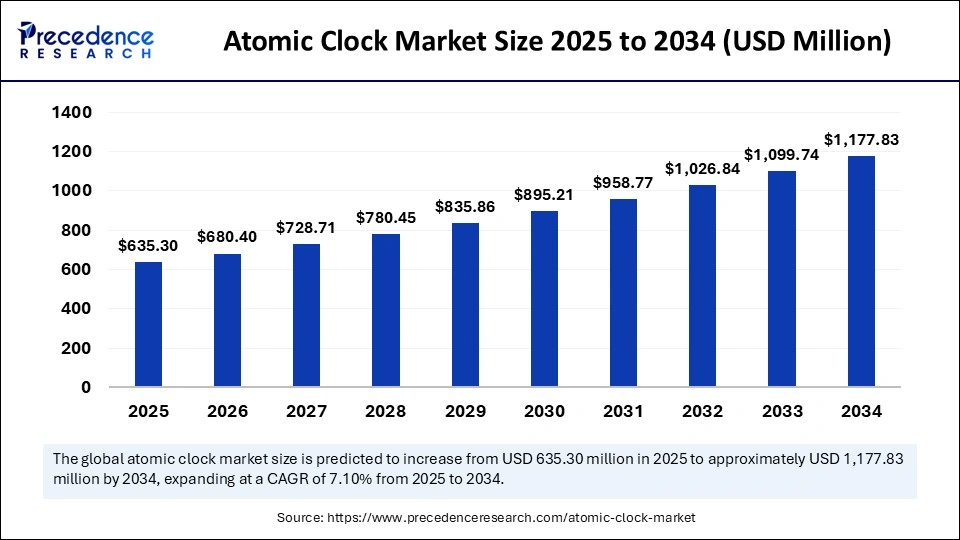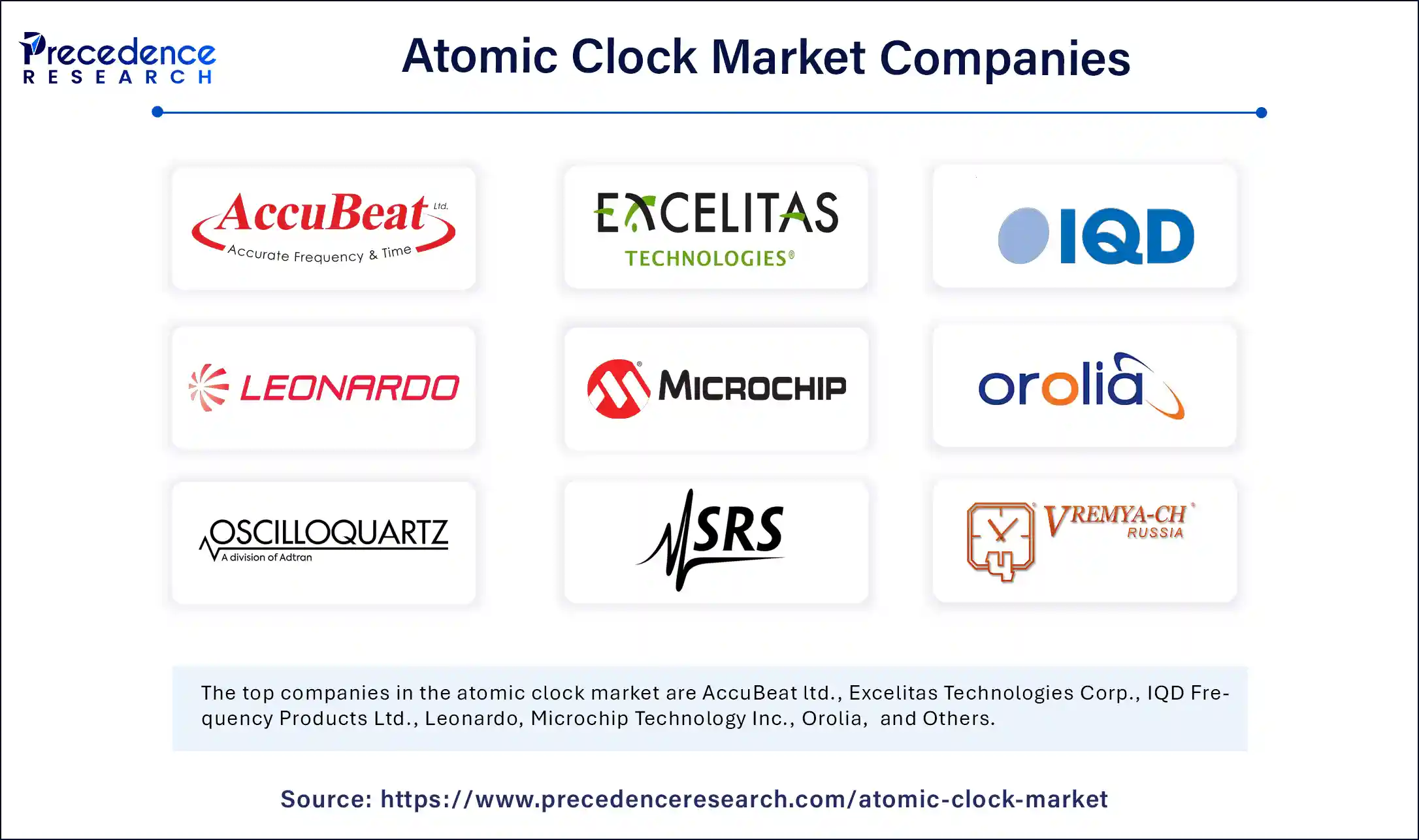
Atomic Clock Market Key Points
-
North America led the atomic clock market with the highest revenue share in 2024.
-
Asia Pacific is projected to grow at the fastest CAGR between 2025 and 2034.
-
The Rubidium (Rb) atomic clock segment accounted for the largest revenue share by type in 2024.
-
The Hydrogen (H) maser atomic clock segment is expected to register a notable CAGR from 2025 to 2034.
-
The aerospace and military segment held the largest revenue share by application in 2024.
-
The scientific and metrology research segment is projected to grow at a significant CAGR during the forecast period from 2025 to 2034.
AI Impact on the Atomic Clock Market
Artificial Intelligence (AI) is playing an increasingly important role in optimizing atomic clock technologies and their applications. AI-driven algorithms enhance the calibration and maintenance processes of atomic clocks by predicting performance deviations and enabling timely corrections, thereby ensuring continuous accuracy. AI also facilitates the synchronization of multiple timing systems across complex networks, improving operational efficiency in telecommunications and defense. Moreover, AI supports the development and control of quantum computing systems, which rely heavily on atomic clocks for precise timekeeping, driving further advancements in both fields.
Market Overview
The atomic clock market is growing steadily due to the increasing demand for ultra-precise timekeeping across a variety of industries. Atomic clocks provide unmatched accuracy and stability, making them essential for critical applications like GPS navigation, telecommunications synchronization, defense systems, and scientific research. Recent technological advancements have enabled the miniaturization of atomic clocks, such as chip-scale atomic clocks (CSACs), making them more accessible for integration into compact devices and emerging fields like the Internet of Things (IoT), autonomous systems, and quantum computing.
Atomic Clock Market Growth Factors
Several key factors are driving growth in the atomic clock market. Technological improvements in miniaturization and energy efficiency allow atomic clocks to be used in a wider range of applications and devices. The growing need for highly accurate timing in sectors such as telecommunications (especially with 5G deployment), aerospace, and defense significantly fuels market demand. Additionally, substantial government funding for research and development in countries like the U.S., China, and India supports innovation and adoption of atomic clock technologies. The surge in quantum technology research further propels market growth by creating new requirements for precision timing.
Get a Free Sample Copy of the Report@ https://www.precedenceresearch.com/sample/6147
Market Scope
| Report Coverage | Details |
| Market Size by 2034 | USD 1,177.83 Million |
| Market Size in 2025 | USD 635.30 Million |
| Market Size in 2024 | USD 593.18 Million |
| Market Growth Rate from 2025 to 2034 | CAGR of 7.10% |
| Dominating Region | North America |
| Fastest Growing Region | Asia Pacific |
| Base Year | 2024 |
| Forecast Period | 2025 to 2034 |
| Segments Covered | Type, Application, and Region |
| Regions Covered | North America, Europe, Asia-Pacific, Latin America, and Middle East & Africa |
Market Dynamics
Market Drivers
Key drivers of the atomic clock market include the rising need for precise synchronization in telecommunications networks, particularly with the global rollout of 5G technology that demands low latency and high data throughput. Defense and aerospace sectors require reliable and highly accurate timing devices for navigation, missile guidance, and satellite communications, which bolster demand. Another driver is the expanding application of atomic clocks in scientific research, including experiments in fundamental physics and space exploration. The growing trend toward integrating atomic clocks into consumer electronics and portable devices also pushes market growth.
Opportunities
The atomic clock market offers various promising opportunities. Emerging economies are increasingly investing in advanced infrastructure and defense systems, creating new markets for precise timing technologies. The expansion of quantum computing and communication research necessitates ultra-accurate clocks, positioning atomic clocks as foundational components. Continued miniaturization and cost reduction open the door for atomic clocks to be embedded in consumer electronics, IoT devices, and autonomous vehicles. Additionally, portable atomic clocks for field operations in military and scientific exploration present a niche but growing market segment.
Challenges
Despite positive prospects, the atomic clock market faces challenges. High manufacturing and development costs due to the sophisticated technology and rare materials involved limit widespread adoption. Integrating atomic clocks into existing infrastructure and systems can be complex, requiring technical expertise and time. In less technologically developed regions, limited awareness about atomic clocks’ benefits restrains market penetration. Furthermore, competition from alternative timing technologies like quartz and GPS-based clocks—which offer sufficient accuracy for many applications at a lower cost—can slow the adoption rate in certain sectors.
Regional Outlook
North America, led by the United States, is the dominant market for atomic clocks due to heavy government investment in defense, space exploration, and telecommunications infrastructure. The Asia-Pacific region is the fastest-growing market, with countries such as China, Japan, and India investing heavily in space programs, 5G infrastructure, and defense modernization, driving demand for atomic clocks. Europe maintains steady growth through integration of atomic clocks in satellite navigation systems and advanced scientific research, with key contributions from Germany and France. Latin America is emerging with Brazil at the forefront, focusing on cesium clock development for aviation and space applications. Meanwhile, the Middle East and Africa are nascent markets but show potential growth as investments in telecommunications and defense infrastructure increase.
Atomic Clock Market Companies

- AccuBeat ltd.
- Excelitas Technologies Corp.,
- IQD Frequency Products Ltd.
- Leonardo
- Microchip Technology Inc.
- Orolia
- Oscilloquartz
- Stanford Research Systems
- Tekron
- VREMYA-CH JSC
Recent Developments
- In April 2025, QuantX Labs, an Australian developer of high-precision quantum timing systems, launch a key component of its TEMPO optical atomic clock into space aboard Exotrail’s spacevan on a SpaceX mission in late 2025. The payload, an optical frequency comb, serves as the enabling subsystem for space-based optical clocks and has completed space-readiness validation, including thermal, vacuum, vibration, and radiation testing.
- In January 2025, Microchip launched its second generation Low-Noise Chip-Scale Atomic Clock (LN-CSAC), model SA65-LN, in a lower profile height and designed to operate in a wider temperature range, enabling low phase noise and atomic clock stability in demanding conditions. The Low-Noise Chip-Scale Atomic Clock, model SA65-LN, enables frequency mixing for battery-powered devices. Together, the LN-CSAC can save board space, design time and overall power consumption compared to designs that feature two oscillators.
- In January 2024, the Academy for Precision Measurement Science and Technology (APM) has developed a new rubidium atomic clock, setting a new international record for stability. This technological breakthrough further expands China’s leading advantage in rubidium atomic clock technology and is of great significance for the development of high-quality microwave oscillator technology and the development of a new generation of Beidou system satellite-borne atomic clocks.
Segments Covered in the Report
By Type
- Rubidium (Rb) Atomic Clock
- Cesium (Cs) Atomic Clock
- Hydrogen (H) Maser Atomic Clock
By Application
- Aerospace and Military
- Scientific and Metrology Research
- Telecom and Broadcasting
By Region
- North America
- Europe
- Asia-Pacific
- Latin America
- Middle East and Africa
Also Read: Fermented Foods Market
Source: https://www.precedenceresearch.com/atomic-clock-market